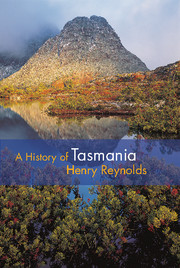Book contents
- Frontmatter
- Contents
- Illustrations
- Acknowledgements
- Introduction
- 1 First Meetings, Extraordinary Encounters
- 2 Van Diemen's Land: Settling in the enviable island
- 3 The Black War: The tragic fate of the Tasmanian Aborigines
- 4 An Indelible Stain?
- 5 The Triumph of Colonisation
- 6 The Politics of Van Diemen's Land
- 7 The Convict System
- 8 Post-penal Depression, 1856–70
- 9 Reform and Recovery
- 10 Federation and War
- 11 Between the Wars
- 12 Postwar Tasmania
- 13 Towards the Bicentenary
- Notes
- Sources
- Index
7 - The Convict System
Published online by Cambridge University Press: 05 April 2012
- Frontmatter
- Contents
- Illustrations
- Acknowledgements
- Introduction
- 1 First Meetings, Extraordinary Encounters
- 2 Van Diemen's Land: Settling in the enviable island
- 3 The Black War: The tragic fate of the Tasmanian Aborigines
- 4 An Indelible Stain?
- 5 The Triumph of Colonisation
- 6 The Politics of Van Diemen's Land
- 7 The Convict System
- 8 Post-penal Depression, 1856–70
- 9 Reform and Recovery
- 10 Federation and War
- 11 Between the Wars
- 12 Postwar Tasmania
- 13 Towards the Bicentenary
- Notes
- Sources
- Index
Summary
Try as they might the Tasmanians found it hard to live down the legacy of the convict system. It had been there from the foundation of the colony in 1803–4 and had overshadowed every aspect of island life for the first 50 years of its existence. A free colony established at the same time would have had a very different history. The large number of impressive Georgian buildings, established to serve the system or constructed for private purposes, were built by convict artisans; the ambitious public works, initiated with gang labour and the expertise of military engineers, were ever-present reminders of the past and in more recent times have been promoted far beyond the island to illustrate the distinctive heritage awaiting the curious tourist. The convict experience, so richly and uniquely recorded by a small industrious army of clerks and other officials, has always been an irresistible attraction to novelists, poets and filmmakers. Every generation of historians have been drawn to the era of transportation in a way that is not true of more recent periods of Tasmanian history, which, in comparison, has appeared to be lacking in drama and colour. By the middle of the 20th century, the ancestral impulse to repress a shameful past had been overcome and families recovered and characteristically celebrated their convict forebears. In her recent book, Tasmania's Convicts, Allison Alexander observed how, from the 1970s, there was a new interest in convicts and there was ‘little shame involved’. Tasmania, she declared,
must be the only community in the entire world with such a large proportion of the population descended from criminals – and proud of it. Tasmania is known for its convict past, and this heritage is viewed not with contempt, or as a cause for shame, but with great interest. The convict past gives Tasmania a unique identity.
While the community has developed a relaxed attitude to the convict past many people were surprised to read Alexander's estimate that 75 per cent of Tasmanians have at least one convict ancestor.
- Type
- Chapter
- Information
- A History of Tasmania , pp. 137 - 163Publisher: Cambridge University PressPrint publication year: 2011



